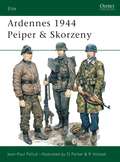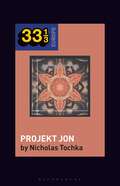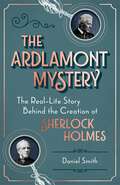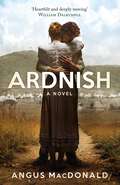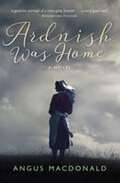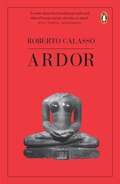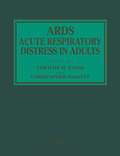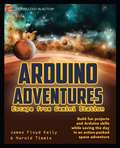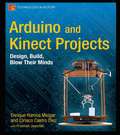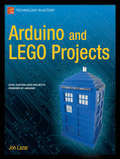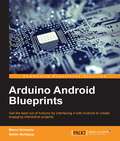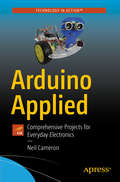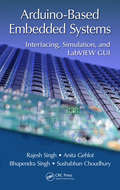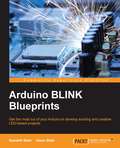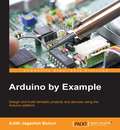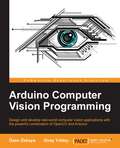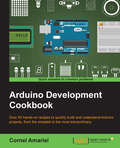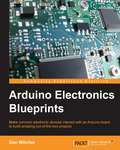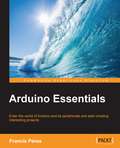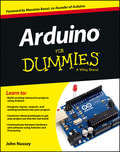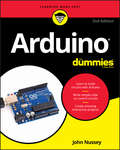- Table View
- List View
Ardennes 1944 Peiper & Skorzeny (Elite)
by David Parker Jean-Paul PalludFrom the earliest planning stages of the German counter-offensive in the Ardennes, Hitler was convinced of the importance of taking the Meuse bridges. He resolved that, when his forces broke through the US lines, one special unit should be dressed in American uniforms and issued with American weapons and vehicles. In this guise they could take advantage of the surprise and shock of the breakthrough, and move forward to the Meuse bridges as if they were retreating Americans. Jean-Paul Pallud details their organisation and the fateful sequence of events that followed.
Ardennes 1944 Peiper & Skorzeny (Elite #11)
by David Parker Jean-Paul PalludFrom the earliest planning stages of the German counter-offensive in the Ardennes, Hitler was convinced of the importance of taking the Meuse bridges. He resolved that, when his forces broke through the US lines, one special unit should be dressed in American uniforms and issued with American weapons and vehicles. In this guise they could take advantage of the surprise and shock of the breakthrough, and move forward to the Meuse bridges as if they were retreating Americans. Jean-Paul Pallud details their organisation and the fateful sequence of events that followed.
Ardit Gjebrea’s Projekt Jon (33 1/3 Europe)
by Professor or Dr. Nicholas TochkaAs market reforms and migration transformed Albania in the early 1990s, Ardit Gjebrea began mixing traditional folk music with world music and Italian pop. The resulting album, Projekt Jon (1997), provided a new model for song-Western and cosmopolitan, yet firmly rooted in the fertile soil of the nation-against a backdrop of deepening political uncertainty about the very future of Albania. The Ionian Project announced itself with the frenetic beating of the daullë and the traditional cries of Albania's highland shepherd. This sprawling collaboration between singer-songwriter Ardit Gjebrea, folk singer Hysni Zela, producer Paul Mazzolini, and a team of crack studio musicians in Italy, had an outsized ambition: to transcend the small postsocialist nation-state's borders, imaginatively crafting through sound a new home in Europe for its citizens. But as Gjebrea prepared to launch Projekt Jon, violence prompted by the collapse of widespread pyramid schemes threatened to tear Albania apart. And for the intellectuals concerned about growing cracks in the symbolic foundations of the Albanian nation-state, the album came to serve as a referendum on the nature of postsocialist citizenship.
Ardit Gjebrea’s Projekt Jon (33 1/3 Europe)
by Professor or Dr. Nicholas TochkaAs market reforms and migration transformed Albania in the early 1990s, Ardit Gjebrea began mixing traditional folk music with world music and Italian pop. The resulting album, Projekt Jon (1997), provided a new model for song-Western and cosmopolitan, yet firmly rooted in the fertile soil of the nation-against a backdrop of deepening political uncertainty about the very future of Albania. The Ionian Project announced itself with the frenetic beating of the daullë and the traditional cries of Albania's highland shepherd. This sprawling collaboration between singer-songwriter Ardit Gjebrea, folk singer Hysni Zela, producer Paul Mazzolini, and a team of crack studio musicians in Italy, had an outsized ambition: to transcend the small postsocialist nation-state's borders, imaginatively crafting through sound a new home in Europe for its citizens. But as Gjebrea prepared to launch Projekt Jon, violence prompted by the collapse of widespread pyramid schemes threatened to tear Albania apart. And for the intellectuals concerned about growing cracks in the symbolic foundations of the Albanian nation-state, the album came to serve as a referendum on the nature of postsocialist citizenship.
The Ardlamont Mystery: The Real-Life Story Behind the Creation of Sherlock Holmes
by Daniel SmithThe real-life mystery featuring the two men – Joseph Bell and Henry Littlejohn – who inspired the creation of Sherlock Holmes.December 1893. Arthur Conan Doyle shocks his legions of fans by killing off the world’s favourite fictional detective, Sherlock Holmes. Meanwhile, in Scotland, a sensational real-life murder trial is playing out. Alfred Monson, a scion of the aristocracy, is charged with killing a young army lieutenant, Cecil Hambrough, on the sprawling Ardlamont estate. The worlds of crime fiction and crime fact are about to collide spectacularly.Among the key prosecution witnesses that the Ardlamont case brought together were two esteemed Edinburgh doctors, Joseph Bell and Henry Littlejohn. Bell – Doyle's tutor when the author studied medicine in the 1870s – had recently been unmasked as the inspiration behind the creation of Sherlock Holmes (Doyle said of Bell, ‘It is most certainly to you that I owe Sherlock Holmes…'). But what the public did not know was that Bell and Littlejohn – a pioneer in the emerging field of forensic detection – had actually been investigating crimes together for more than twenty years. Largely unacknowledged, Littlejohn deserves equal billing as the prototype of Baker Street's most famous resident.In The Ardlamont Mystery, author Daniel Smith re-examines the evidence of the case that gripped Victorian Britain, putting forward his own theory as to why Cecil Hambrough was murdered. Outlining the key roles of the men whose powers of deduction and detection had so inspired Doyle, Smith explores the real-world origins of Sherlock Holmes through the prism of a mystery as engrossing as any case the Great Detective ever tackled. Will Bell and Littlejohn’s shared faith in science and reason be enough to see justice win out?
Ardnish: A Novel (The\ardnish Ser. #2)
by Angus MacDonaldPraise for the Ardnish Series'What I really enjoyed about this book was its beauty, an enthralling read that is both brutal and poetic' – Daily Record‘A fast-paced narrative with deeply likeable characters ... far more than yet another wartime love story ... impossible to put down’ – Scottish Field, Book of the Month‘Not only a gripping and at times horrifying adventure . . . it is also an important piece of social history. But perhaps above all, it is a tale of the importance of true love and determination’ – Scots MagazineArdnish, the Highlands of Scotland, 1944. On his deathbed, Donald John Gillies sends for a priest to hear his last confession. During his 85 years he has witnessed much – world wars, the loss of family through death and emigration, and the daily struggles which face the small remote community.Waiting anxiously for the priest, his mind travels back to the dusty plains of South Africa in 1901, where he fought as a Lovat Scout during the Boer War, and where he met the woman who was the love of his life. Forced to abandon her and her young daughter in a British concentration camp, DJ returns to Scotland and his old life after his camp is ambushed by Boers and many of his fellow soldiers are massacred.As he lies dying, an unexpected visitor arrives at Ardnish. making it more imperative then ever for DJ to come to terms with the past and to make peace with himself – and his family – while there is still time.
Ardnish Was Home: A Novel (Ardnish Ser.)
by Angus MacDonaldGallipoli, 1915. Donald Peter Gillies, a young Lovat Scout soldier, lies in a field hospital, blinded by the Turks. There he falls in love with his Queen Alexandra Corps nurse, Louise, and she with him. As they talk in the quiet hours he tells her of life in the West Highlands of Scotland, where he grew up, and she in turn tells her own story of a harsh and unforgiving upbringing in the Welsh valleys. Cut off from Allied troops, Donald and Louise make a perilous escape through Turkey, Greece and on to Malta – the first stage on their journey to a new life together in Donald’s beloved Ardnish. But just as they are within reach of home, Fate deals an unexpected hand . . .
Ardor
by Roberto CalassoIn this revelatory volume, Roberto Calasso, whom the Paris Review has called 'a literary institution', explores the ancient texts known as the Vedas. Little is known about the Vedic people who lived more than three thousand years ago in northern India: they left behind almost no objects, images, ruins. They created no empires. Even the hallucinogenic plant, the soma, which appears at the centre of some of their rituals, has not been identified with any certainty. Only a 'Parthenon of words' remains: verses and formulations suggesting a daring understanding of life. 'If the Vedic people had been asked why they did not build cities,' writes Calasso, 'they could have replied: we did not seek power, but rapture.' This is the ardor of the Vedic world, a burning intensity that is always present, both in the mind and in the cosmos. With his signature erudition and profound sense of the past, Calasso explores the enigmatic web of ritual and myth that define the Vedas. Often at odds with modern thought, he shows how these texts illuminate the nature of consciousness more than neuroscientists have been able to offer us up to now. Following the 'hundred paths' of the Satapatha Brahmana, an impressive exegesis of Vedic ritual, Ardor indicates that it may be possible to reach what is closest by passing through that which is most remote, as 'the whole of Vedic India was an attempt to think further'.
ARDS Acute Respiratory Distress in Adults
by Timothy W. Evans C. HaslettGreat progress has been made since the first description of the acute respiratory distress syndrome by the Denver group in 1967 (Lancet). Although we introduced the term 'adult respiratory distress syndrome' in our second and more detailed description of the syndrome (ehest, 1971), this was probably amistake for the simple reason that children also suffer the same syndrome fo11owing acute lung insults. Today, the syndrome of acute respiratory distress in adults (ARDS) is recognized as a worldwide problem, but the prevalence of disease varies in different parts of the world. A huge amount of research has focused on the mechanisms of acute lung injury and yet the exact sequence of events and media tors in inflammatory cascade, which result in acute respiratory failure from ARDS, is not known but many possibilities exist. The definition of ARDS has been gradua11y modified in recent years and investigators around the world are now co11aborating in order to establish more uniform concepts in identification, risk factors and mechanisms of lung injury, which someday will result in improved approaches to management. Already, at least some centers are showing improved outcomes in ARDS, achieving an approximate 60% survival rate. In the past, most large series documented only about a 40% survivability taking a11 causes of ARDS. This apparent progress is likely attributable to more meticulous and disciplined care than any specific pharmacologic attack on the basic mechanism resulting in ARDS.
Arduino Adventures: Escape from Gemini Station
by James Floyd Kelly Harold TimmisArduino Adventures: Escape from Gemini Station provides a fun introduction to the Arduino microcontroller by putting you (the reader) into the action of a science fiction adventure story. You'll find yourself following along as Cade and Elle explore Gemini Station—an orbiting museum dedicated to preserving and sharing technology throughout the centuries. Trouble ensues. The station is evacuated, including Cade and Elle's class that was visiting the station on a field trip. Cade and Elle don&’t make it aboard their shuttle and are trapped on the station along with a friendly artificial intelligence named Andrew who wants to help them get off the damaged station. Using some old hardware, a laptop, and some toolboxes full of electronics parts, you will follow along and build eight gizmos with Cade and Elle that will help them escape from Gemini Station. The hardware is Arduino. Each new challenge opens a new area of Arduino and basic electronics knowledge. You&’ll be taken incrementally from a simple task such as turning on a light through to a complex combination of microcontroller, electronic components, and software programming. By the end of the book you&’ll be well on your way towards being able to create and implement any sort of electronically controlled device you can imagine, using the stunningly popular Arduino microcontroller. Provides eight challenges, each challenge increasing in complexity Builds around a fictional storyline that keeps the learning fun Leaves you on a solid foundation of electronic skills and knowledge
Arduino and Kinect Projects: Design, Build, Blow Their Minds
by Enrique Ramos Melgar Ciriaco Castro DiezIf you've done some Arduino tinkering and wondered how you could incorporate the Kinect—or the other way around—then this book is for you. The authors of Arduino and Kinect Projects will show you how to create 10 amazing, creative projects, from simple to complex. You'll also find out how to incorporate Processing in your project design—a language very similar to the Arduino language. The ten projects are carefully designed to build on your skills at every step. Starting with the Arduino and Kinect equivalent of "Hello, World," the authors will take you through a diverse range of projects that showcase the huge range of possibilities that open up when Kinect and Arduino are combined. Gesture-based Remote Control. Control devices and home appliances with hand gestures. Kinect-networked Puppet. Play with a physical puppet remotely using your whole body. Mood Lamps. Build your own set of responsive, gesture controllable LED lamps. Drawing Robot. Control a drawing robot using a Kinect-based tangible table. Remote-controlled Vehicle. Use your body gestures to control a smart vehicle. Biometric Station. Use the Kinect for biometric recognition and checking Body Mass Indexes. 3D Modeling Interface. Learn how to use the Arduino LilyPad to build a wearable 3D modelling interface. 360º Scanner. Build a turntable scanner and scan any object 360º using only one Kinect. Delta Robot. Build and control your own fast and accurate parallel robot.
Arduino and LEGO Projects
by Jon LazarWe all know how awesome LEGO is, and more and more people are discovering how many amazing things you can do with Arduino. In Arduino and LEGO Projects, Jon Lazar shows you how to combine two of the coolest things on the planet to make fun gadgets like a Magic Lantern RF reader, a sensor-enabled LEGO music box, and even an Arduino-controlled LEGO train set. Learn that SNOT is actually cool (it means Studs Not on Top) See detailed explanations and images of how everything fits together Learn how Arduino fits into each project, including code and explanations Whether you want to impress your friends, annoy the cat, or just kick back and bask in the awesomeness of your creations, Arduino and LEGO Projects shows you just what you need and how to put it all together.
Arduino Android Blueprints
by Marco Schwartz Stefan ButtigiegThis book is for those who want to learn how to build exciting Arduino projects by interfacing it with Android. You will need to have some basic experience in electronics and programming. However, you don't need to have any previous experience with the Arduino or Android platforms.
Arduino Applied: Comprehensive Projects for Everyday Electronics
by Neil CameronExtend the range of your Arduino skills, incorporate the new developments in both hardware and software, and understand how the electronic applications function in everyday life. This project-based book extends the Arduino Uno starter kits and increases knowledge of microcontrollers in electronic applications. Learn how to build complex Arduino projects, break them down into smaller ones, and then enhance them, thereby broadening your understanding of each topic.You'll use the Arduino Uno in a range of applications such as a blinking LED, route mapping with a mobile GPS system, and uploading information to the internet.You'll also apply the Arduino Uno to sensors, collecting and displaying information, Bluetooth and wireless communications, digital image captures, route tracking with GPS, controlling motors, color and sound, building robots, and internet access. With Arduino Applied, prior knowledge of electronics is not required, as each topic is described and illustrated with examples using the Arduino Uno.What You’ll LearnSet up the Arduino Uno and its programming environmentUnderstand the application of electronics in every day systemsBuild projects with a microcontroller and readily available electronic componentsWho This Book Is ForReaders with an Arduino starter-kit and little-to-no programming experience and those interested in "how electronic appliances work."
Arduino-Based Embedded Systems: Interfacing, Simulation, and LabVIEW GUI
by Rajesh Singh Anita Gehlot Bhupendra Singh Sushabhan ChoudhuryArduino is an open-source electronics platform based on easy-to-use hardware and software while LabVIEW is a graphical programming telling how to connect functions and work with a variety of datatypes when constructing applications.This book will help beginners to get started with Arduino-based embedded systems including essential know-how of the programming and interfacing of the devices. Book includes programming and simulation of Arduino-based projects and interfacing with LabVIEW, based on practical case studies. The book comprises of total twenty five chapters with description, working model of LabVIEW and programming with Arduino IDE.
Arduino-Based Embedded Systems: Interfacing, Simulation, and LabVIEW GUI
by Rajesh Singh Anita Gehlot Bhupendra Singh Sushabhan ChoudhuryArduino is an open-source electronics platform based on easy-to-use hardware and software while LabVIEW is a graphical programming telling how to connect functions and work with a variety of datatypes when constructing applications.This book will help beginners to get started with Arduino-based embedded systems including essential know-how of the programming and interfacing of the devices. Book includes programming and simulation of Arduino-based projects and interfacing with LabVIEW, based on practical case studies. The book comprises of total twenty five chapters with description, working model of LabVIEW and programming with Arduino IDE.
Arduino by Example
by Adith Jagadish BoloorDesign and build fantastic projects and devices using the Arduino platform About This Book • Explore the different sensors that can be used to improve the functionality of the Arduino projects • Program networking modules in conjunction with Arduino to make smarter and more communicable devices • A practical guide that shows you how to utilize Arduino to create practical, useful projects Who This Book Is For This book is an ideal choice for hobbyists or professionals who want to create quick and easy projects with Arduino. As a prerequisite, readers must have a working Arduino system and some programming background, ideally in C/C++. Basic knowledge of Arduino is helpful but not required to follow along with this book. What You Will Learn • Understand and utilize the capabilities of the Arduino • Integrate sensors to gather environmental data and display this information in meaningful ways • Add modules such as Bluetooth and Wi-fithat allow the Arduino to communicate and send data between devices • Create simple servers to allow communication to occur • Build automated projects including robots while learning complex algorithms to mimic biological locomotion • Implement error handling to make programs easier to debug and look more professional • Integrate powerful programming tools and software such as Python and Processing to broaden the scope of what the Arduino can achieve • Practice and learn basic programming etiquette In Detail Arduino an opensource physical computing platform based on a simple microcontroller board, and a development environment for writing software for the board. The opensource Arduino software (IDE) makes it easy to write code and upload it to the board. It runs on Windows, Mac OS X, and Linux. The environment is written in Java and based on Processing and other opensource software. With the growing interest in home-made, weekend projects among students and hobbyists alike, Arduino offers an innovative and feasible platform to create projects that promote creativity and technological tinkering. Arduino by Example is a project-oriented guide to help you fully utilize the power of one of the world's most powerful open source platforms, Arduino. This book demonstrates three projects ranging from a home automation project involving your lighting system to a simple robotic project to a touch sensor project. You will first learn the basic concepts such as how to get started with the Arduino, and as you start building the project, you will develop the practical skills needed to successfully build Arduino powered projects that have real-life implications. The complexity of the book slowly increases as you complete a project and move on to the next. By the end of this book, you will be able to create basic projects and utilize the elements used in the examples to construct your own devices. Style and approach This book follows a project-oriented approach, with multiple images and plenty of code to help you build your projects easily. The book uses a tutorial-based methodology where the concepts are first explained and then implemented to help you develop the projects.
Arduino Computer Vision Programming
by Ozen Ozkaya Giray YillikciDesign and develop real-world computer vision applications with the powerful combination of OpenCV and Arduino About This Book • Load and run the applications in Arduino to develop intelligent systems • Design and implement detection, classification, and recognition algorithms for computer vision applications • Explore the best practices of computer vision development including state of the art algorithms and hands-on example projects Who This Book Is For If you are a consumer and hobbyist who has familiarity with the basics of Arduino and wish to learn computer vision programming with Arduino to create intelligent systems, then this book is for you. No knowledge of computer vision programming is required. What You Will Learn • Understand the design blocks and the generic architecture of computer vision systems by learning an efficient approach to modelling • Build up your skill set of computer vision system design using OpenCV by learning fundamentals, camera selection, data acquisition, filtering, processing, feature extraction and recognition for any specific problem • Learn the wired and wireless communication capabilities of Arduino and comprehensive best practices to connect it to the OpenCV environment in a platform-independent way • Discover how to use Arduino to elegantly interact with real life via physical actions • Solidify everything you've learnt by designing and building a computer vision-enabled practical robot from scratch In details Most technologies are developed with an inspiration of human capabilities. Most of the time, the hardest to implement capability is vision. Development of highly capable computer vision applications in an easy way requires a generic approach. In this approach, Arduino is a perfect tool for interaction with the real world. Moreover, the combination of OpenCV and Arduino boosts the level and quality of practical computer vision applications. Computer vision is the next level of sensing the environment. The purpose of this book is to teach you how to develop Arduino-supported computer vision systems that can interact with real life by seeing it. This book will combine the powers of Arduino and computer vision in a generalized, well-defined, and applicable way. The practices and approaches in the book can be used for any related problems and on any platforms. At the end of the book, you should be able to solve any types of real life vision problems with all its components by using the presented approach. Each component will extend your vision with the best practices on the topic. In each chapter, you will find interesting real life practical application examples about the topics in the chapter. To make it grounded, we will build a vision-enabled robot step by step towards the end of the book. You will observe that, even though the contexts of the problems are very different, the approaches to solve them are the same and very easy! Style and approach This book is a step-by-step guide that explains each topic sequentially by using best practices and useful tips to build computer-vision applications with OpenCV and Arduino. All the information in the book is combined in a real life all-in-one example application.
Arduino Data Communications: Learn how to configure databases, MQTT, REST APIs, and store data over LoRaWAN, HC-12, and GSM
by Robert Thas JohnBuild real-world, scalable, and fault-tolerant IoT systems using Arduino MKR boards that collect, transmit, and store data on a massive scale in a structured databaseKey FeaturesSet up databases to store and retrieve information collected from various sensorsIngest your data into your database for storage with REST APIs and MQTTCommunicate with your application layer using different communication technologies from Arduino MKR and Portenta H7Purchase of the print or Kindle book includes a free PDF eBookBook DescriptionIn our modern, internet-connected world, where billions of devices constantly collect and send data to systems to be stored and processed, it’s surprising how the intricacies of data transmission and storage are often overlooked in the IoT domain. With Arduino Data Communications, you'll bridge the knowledge gap and become an expert in collecting data from IoT sensors, transmitting data, and configuring your own databases. This book is an exploration of IoT’s inner workings, guiding you through the process of setting up an end-to-end system that you can employ to prototype your own IoT solutions, using easy-to-follow examples. It begins with a general overview of the Arduino ecosystem, acquainting you with various sensors and shields and unveiling the art of data collection. You’ll then explore data formats and methods to store data, both locally and on database servers. As you progress through the chapters, you’ll learn how to set up REST and MQTT infrastructure to communicate with databases and get hands-on with LoRaWAN, Ethernet, cellular, HC-12, and RS-485. The final chapters are your training ground for real-world projects, imparting the essential knowledge you need to tackle complex challenges with confidence. By the end of this Arduino book, you'll have seamlessly configured an end-to-end system, all while immersing yourself in practical scenarios that bring the world of IoT to life.What you will learnExplore data storage formats for both local and remote storage solutionsBuild projects that leverage the variety of communication standardsSet up a database to host data transmitted from various projectsUse MQTT and RESTful APIs to send data from devices to remote systemsPrepare for multiple devices using high availability measuresUse LoRa by implementing a gateway and a clientTransmit temperature and humidity data over RS-485 and HC-12Who this book is forThis book is for embedded systems engineers and electronics engineers who want to build IoT devices and gain insights into storing data collected from these devices, as well as establish communication between devices. The skills you learn in this book will come in handy even if your final product isn't built on Arduino. While prior experience with computers is assumed, expertise with embedded systems such as Arduino is not a prerequisite. Familiarity with Arduino programming will be beneficial, but not necessary.
Arduino Development Cookbook
by Cornel AmarieiIf you want to build programming and electronics projects that interact with the environment, this book will offer you dozens of recipes to guide you through all the major applications of the Arduino platform. It is intended for programming or electronics enthusiasts who want to combine the best of both worlds to build interactive projects.
Arduino Electronics Blueprints
by Don WilcherThis book is intended for those who want to learn about electronics and coding by building amazing devices and gadgets with Arduino. If you are an experienced developer who understands the basics of electronics, then you can quickly learn how to build smart devices using Arduino. The only experience needed is a desire to learn about electronics, circuit breadboarding, and coding.
Arduino Essentials
by Francis PereaIf you are a hobbyist who wants to develop projects based on Arduino as the main microcontroller platform or an engineer interested in finding out what the Arduino platform offers, then this book is ideal for you. Some prior knowledge of the C programming language is required.
Arduino For Dummies
by John NusseyThe quick, easy way to leap into the fascinating world of physical computing This is no ordinary circuit board. Arduino allows anyone, whether you're an artist, designer, programmer or hobbyist, to learn about and play with electronics. Through this book you learn how to build a variety of circuits that can sense or control things in the real world. Maybe you'll prototype your own product or create a piece of interactive artwork? This book equips you with everything you'll need to build your own Arduino project, but what you make is up to you! If you're ready to bring your ideas into the real world or are curious about the possibilities, this book is for you. ? Learn by doing ? start building circuits and programming your Arduino with a few easy to follow examples - right away! ? Easy does it ? work through Arduino sketches line by line in plain English, to learn of how a they work and how to write your own ? Solder on! ? Only ever used a breadboard in the kitchen? Don't know your soldering iron from a curling iron? No problem, you'll be prototyping in no time ? Kitted out ? discover new and interesting hardware to make your Arduino into anything from a mobile phone to a geiger counter! ? Become an Arduino savant ? learn all about functions, arrays, libraries, shields and other tools of the trade to take your Arduino project to the next level. ? Get social ? teach your Arduino to communicate with software running on a computer to link the physical world with the virtual world It's hardware, it's software, it's fun! Start building the next cool gizmo with Arduino and Arduino For Dummies.
Arduino For Dummies
by John NusseyBring your ideas to life with the latest Arduino hardware and software Arduino is an affordable and readily available hardware development platform based around an open source, programmable circuit board. You can combine this programmable chip with a variety of sensors and actuators to sense your environment around you and control lights, motors, and sound. This flexible and easy-to-use combination of hardware and software can be used to create interactive robots, product prototypes and electronic artwork, whether you’re an artist, designer or tinkerer. Arduino For Dummies is a great place to start if you want to find out about Arduino and make the most of its incredible capabilities. It helps you become familiar with Arduino and what it involves, and offers inspiration for completing new and exciting projects. • Covers the latest software and hardware currently on the market • Includes updated examples and circuit board diagrams in addition to new resource chapters • Offers simple examples to teach fundamentals needed to move onto more advanced topics • Helps you grasp what’s possible with this fantastic little board Whether you’re a teacher, student, programmer, hobbyist, hacker, engineer, designer, or scientist, get ready to learn the latest this new technology has to offer!
